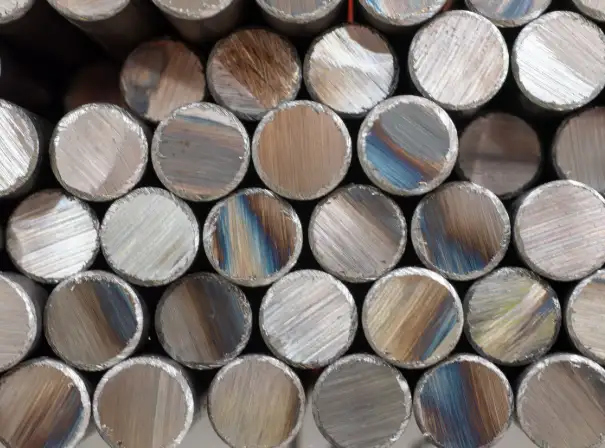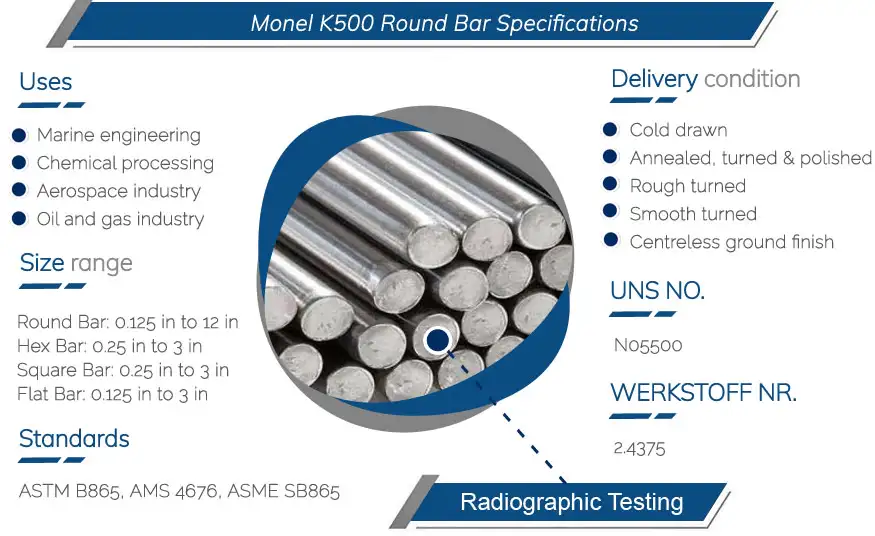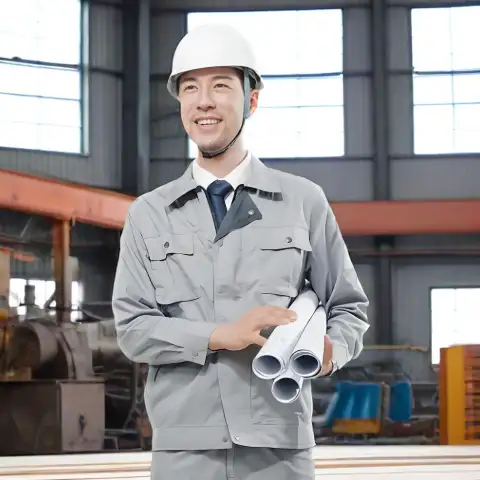Monel is a family of nickel–copper alloys prized for exceptional resistance to seawater and many chemical environments, combined with good mechanical strength; because of that combination it is most commonly used for marine hardware, valves and pumps, oil & gas down-hole equipment, chemical processing components, and specialty fasteners — and when higher strength is required the age-hardenable grade K-500 is chosen.
Short history and what makes Monel special
Monel was developed in the early 20th century and became widely adopted because its blend of nickel and copper produces an alloy with unusually good resistance to flowing seawater, chloride-bearing media and many acids, while remaining workable and weldable for engineering components. Early adoption in marine and naval work set the tone — Monel remains the go-to material where standard stainless steels or copper alloys fail because of aggressive chloride attack or sulfide corrosion.

Chemistry and commercial grades
Monel is not a single chemical formula but a family of nickel–copper alloys with related chemistries. The two most commonly specified commercial grades are Monel 400 (also written Alloy 400, UNS N04400) and Monel K-500 (UNS N05500). Other specialized Monel grades (for example Monel 404 and other proprietary designations) exist for electrical or brazing uses.
Representative nominal compositions
(Table shows typical nominal ranges; suppliers publish exact compositions and tolerances.)
| Element / Grade | Monel 400 (typical) | Monel K-500 (typical) |
|---|---|---|
| Nickel (Ni) | ~63–67% | ~63% |
| Copper (Cu) | ~28–34% | ~29–31% |
| Iron (Fe) | 0.5–2.5% | ~2.0% |
| Manganese (Mn) | ≤2% | ~1.2–1.5% |
| Carbon (C) | ≤0.3% | ≤0.15–0.20% |
| Aluminum (Al) | — | ~2.0–3.0% (for age hardening) |
| Titanium (Ti) | — | ~0.4–0.8% (for age hardening) |
| Silicon (Si) | ≤0.5% | ≤0.5% |
These nominal values reflect common commercial datasheets; precise compositions vary by specification and mill. Monel K-500 integrates aluminum and titanium to enable precipitation (age) hardening, giving substantially higher tensile and yield strength after proper heat treatment.
Mechanical and physical properties
Monel alloys combine toughness, ductility and corrosion resistance over a wide temperature range. They are non-ferrous and generally non-magnetic in annealed condition (K-500 can be slightly magnetic after aging).
Typical mechanical properties (annealed vs aged)
| Property | Monel 400 (annealed) | Monel K-500 (precipitation hardened) |
|---|---|---|
| Tensile strength (approx.) | 70–110 ksi (480–760 MPa) depending on form and cold work | 120–180 ksi (830–1240 MPa) after aging |
| Yield strength (approx.) | 20–45 ksi (140–310 MPa) | 100–150 ksi (690–1030 MPa) after aging |
| Elongation (in 2") | 20–40% | 8–25% depending on age condition |
| Hardness (HRB/HRC scale) | Annealed ~60–90 HRB | Aged up to ~30–40 HRC (depending on treatment) |
| Density | ~8.8–8.9 g/cm³ | similar |
| Melting range | 1200–1350 °C (approximate solidus/liquidus window) | similar |
Manufacturers publish form- and heat-treatment-specific values; the numbers above are for orientation only. Monel 400 is strengthened primarily by cold work; K-500 achieves much higher static strength via precipitation of Ni₃(Ti,Al) particles during controlled aging.
Corrosion performance and common service environments
Monel is renowned for broad corrosion resistance but it is not immune to all forms of attack. Understanding the particular environment is essential to selecting the right grade.
Corrosion characteristics (practical notes)
-
Seawater and flowing salt water: Monel 400 resists uniform corrosion and pitting in natural seawater and is one of the preferred alloys for marine hardware. It performs very well in rapidly flowing brackish or seawater environments where many stainless steels suffer localized attack.
-
Chloride stress-corrosion cracking (SCC): Monel 400 shows very good resistance to chloride SCC in most fresh waters — an advantage over austenitic stainless steels in some situations.
-
Acids and alkalis: Monel 400 has useful resistance to many acids (notably dilute sulfuric and phosphoric acid when de-aerated) and performs well against caustic alkali solutions. For some oxidizing acids and high-temperature oxidizing conditions, other alloys may be superior.
-
Hydrogen sulfide and sour environments: Monel K-500 and 400 are often used in oil and gas environments with sulfide stress-cracking concerns because of good resistance, but care with specific sulfide and temperature combinations is required.
Corrosion environment quick reference table
| Environment | Typical Monel response |
|---|---|
| Natural seawater, brackish water | Excellent resistance; common choice for hardware, shafts, fittings. |
| Chloride-bearing process streams | Generally good resistance; localized corrosion less than many stainless steels if conditions are right. |
| Reducing acids (de-aerated HCl/HF) | Better than many alloys in de-aerated conditions; check specific concentration & temperature. |
| Caustic (NaOH, KOH) | Good resistance up to service limits; consult data for specific concentrations/temperatures. |
| Oxidizing acids at elevated temperature | Use caution — other nickel alloys (e.g., Hastelloy family) may be superior. |
When designers require both corrosion resistance and high strength the choice often falls to K-500; when maximum ductility and weldability are needed, 400 is usually preferred.

Primary industries and typical components
Monel’s balance of corrosion resistance, mechanical performance and fabricability makes it valuable across several sectors. The table below maps common industry needs to specific components where Monel is frequently specified.
| Industry | Typical Monel grade(s) | Typical components & uses |
|---|---|---|
| Marine & shipbuilding | 400 | Propeller shafts, fasteners, seawater piping, strainers, hull fittings, deck hardware. |
| Oil & gas (onshore & offshore) | K-500, 400 | Drill collars, pump shafts, valve components, riser and subsea fasteners, down-hole tool components. |
| Chemical processing | 400, K-500 | Heat-exchanger tubes, pump parts, valve trim, agitators, scrubber internals — where chloride or sulfide corrosion is present. |
| Power generation | 400, specialized Monels | Turbine and generator hardware exposed to seawater or flue gases, condenser and cooling systems. |
| Aerospace & defense | K-500, specialty Monels | Fasteners and high-strength fittings where corrosion and strength criteria coexist. |
| Musical instruments & consumer goods (historical) | 400 | Strings, mouthpieces and architectural features (some older decorative uses). |
| Marine instrumentation & sensors | 400, 404 | Sensor housings and electrical contacts where corrosion and specific magnetic properties are required. |
Why Monel is chosen component-by-component: where wet, chloride-bearing or sulfide-rich environments would attack ordinary steels or copper alloys, Monel gives long service life with comparatively low maintenance — often a lower total-life-cost choice despite higher raw material cost.
Fabrication, machining, welding and joining
Understanding fabrication characteristics helps turn material capability into reliable parts.
Fabrication notes
-
Forming and cold work: Monel 400 can be cold-worked to raise strength significantly. K-500 is age-hardenable and normally solution-treated before aging cycles. Cold forming of K-500 should account for final aging to reach design strength.
-
Machinability: Monel machines differently than carbon steel; it tends to work-harden and will blunt tools if feed and speeds are not adjusted. Carbide tooling and rigid setups are common best practice.
-
Welding: Both 400 and K-500 can be welded; K-500 requires attention because welding locally alters precipitation hardening and can produce softened zones. Post-weld heat treatment or controlled aging is often necessary for K-500 parts to recover mechanical properties. Monel 400 welds readily with compatible nickel-copper filler metals.
-
Brazing & soldering: Certain Monel grades and grades like 404 are used where brazeability and electrical characteristics matter; use appropriate fluxes and filler metals.
-
Surface finish & passivation: Monel does not form a true chromium oxide passive film like stainless steels; its corrosion resistance arises from alloy chemistry and surface films appropriate to nickel–copper systems. Standard cleaning and finishing practices apply.
Design considerations and limitations
Monel is versatile but designers should weigh tradeoffs:
Advantages
-
Excellent resistance to seawater, many acids and alkalis.
-
High ductility and toughness (400), and high strength after aging (K-500).
-
Good resistance to chloride SCC compared with many stainless steels.
Limitations
-
Cost: Nickel content makes Monel substantially more expensive than carbon steel and many stainless steels; economic selection must consider lifecycle cost, not only initial price.
-
High-temperature strength & oxidation: For very high temperatures or strongly oxidizing atmospheres other nickel alloys (e.g., Inconel, Hastelloy) often outperform Monel.
-
Work hardening during machining: Requires experienced machinists and appropriate tool choices.
-
Hydrogen embrittlement and specific sulfide conditions: While generally resistant, certain combinations of temperature, pressure and sulfide concentration require careful qualification and testing.
Standards, specifications and procurement
Monel products are produced to well-established ASTM/ASME and national standards that define chemistry, mechanical properties and acceptable product forms (bar, plate, tube, pipe, forging, weld wire).
Key standards frequently referenced by engineers and procurement:
-
ASTM B164 — Standard specification for nickel–copper alloy rod, bar and wire (covers Monel 400 rod/bar).
-
ASTM B127 — Plate, sheet and strip for Monel 400
-
ASTM B165 — Seamless and welded pipe and tube for nickel–copper alloys including Monel.
-
ASME SB and related codes — For pressure vessels, piping components, and weld materials derived from ASTM standards.
-
Manufacturer technical bulletins and datasheets — Special Metals, Ulbrich, and other primary mills provide detailed heat-treatment and fabrication guidance.
Procurement checklist: specify UNS number (e.g., N04400 or N05500), required product form and finish, mechanical property acceptance criteria, heat treatment state (annealed/aged), and required test certificates (e.g., EN 10204/3.1).
How Monel compares to alternative alloys
When selecting materials, engineers routinely compare Monel with stainless steels, copper-nickel and higher-nickel superalloys.
Quick comparison table
| Characteristic | Monel 400 / K-500 | Duplex / 316L stainless | Cu-Ni (70/30) | Inconel / Hastelloy |
|---|---|---|---|---|
| Seawater resistance | Excellent | Good (but pitting possible) | Good | Excellent |
| Chloride SCC resistance | Very good | Variable, less resistant in some conditions | Good | Excellent |
| High-temperature oxidation resistance | Moderate | Moderate | Poor | Excellent |
| Strength (as-worked/aged) | 400 moderate, K-500 high | High (heat resistant duplex) | Low–moderate | Very high at elevated T |
| Cost (material) | High | Moderate | Moderate | Very high |
| Fabrication ease | Good (requires care) | Good | Easy | Difficult/expensive |
Choosing Monel is justified when chloride, seawater or sulfide resistance plus strength are the primary requirements and total lifecycle cost favors a higher-performance alloy.
Typical field examples and short case notes
-
Offshore platform riser components and fasteners: Monel 400 is often used for fasteners and small fittings exposed to seawater where stainless steels would pit or crevice corrode.
-
Pump shafts and propeller shafts: Because Monel resists erosion and corrosion in flowing salt water, shafts and rotating hardware frequently employ Monel 400.
-
Oil-well down-hole tools: K-500’s high strength and corrosion resistance are applied in drill collars, connectors and special tool parts where mechanical load and corrosive fluids combine.
-
Chemical plant valve trim: Valve seats, stems and internals in chloride or sulfide service use Monel for extended life and reduced maintenance.
Life-cycle, maintenance and repair
Monel parts in marine and process environments generally show long service life; routine inspection for mechanical wear, erosion and localized corrosion is typical.
Repair strategies:
-
Welding repairs: Use recommended nickel-copper filler metals; for K-500 evaluate need for post-weld aging to recover mechanical performance.
-
Surface rebuilding and hardfacing: For components suffering mechanical erosion, rebuild with compatible Monel welding consumables.
-
Cathodic protection: In some subsea systems cathodic protection complements Monel’s corrosion resistance, particularly for connected dissimilar metal systems.
Sustainability and recyclability
Monel alloys are recyclable like other nickel alloys. Recycling reduces embodied energy and raw-material extraction impacts compared with producing primary nickel. For procurement teams, specify reclaimed content or mill certification if sustainability targets require it. End-of-life material value is high because of significant nickel and copper content.
Practical selection checklist
-
Identify fluid chemistry (chloride concentration, oxidizing vs reducing, sulfide content).
-
Define temperature and pressure ranges.
-
Decide required mechanical properties (yield/tensile). If high static strength is needed, consider K-500 and specify aging.
-
Check weldability & fabrication plans — specify pre- and post-heat treatment if needed.
-
Review ASTM/ASME specification numbers and include UNS designation in procurement.
FAQs
-
What is Monel made of?
Monel is a nickel–copper alloy family. Monel 400 is mainly nickel (~63–67%) with about 28–34% copper; K-500 has similar base composition plus small aluminum and titanium additions for precipitation hardening. -
Which Monel grade should I choose for seawater service?
Monel 400 is the default for many seawater applications because of its excellent resistance to seawater corrosion and abrasion. Use K-500 if you also need higher static strength. -
Can Monel be welded and will welding change properties?
Yes, Monel welds well with appropriate filler metals. K-500 can lose age-hardening in the heat-affected zone and may require post-weld aging. -
How does Monel compare to 316 stainless steel in marine use?
Monel typically resists pitting and crevice corrosion in seawater better than 316, especially in flowing or aerated seawater. However 316 can be cheaper and is adequate for many milder conditions. -
Is Monel magnetic?
Annealed Monel 400 is essentially non-magnetic; K-500 can show slight magnetic response depending on heat treatment. -
Why is Monel more expensive than copper-nickel?
Higher nickel content and more complex metallurgy increase raw material and processing cost; the premium is paid for superior performance in aggressive environments. -
What standards should procurement reference?
Reference ASTM B164 for rod/bar, B127 for plate/sheet, B165 for tube/pipe, plus their ASME equivalents and the UNS number (N04400, N05500). -
Can Monel be used at high temperatures?
Monel has usable strength to several hundred °C, but for very high temperatures or strongly oxidizing atmospheres choose high-nickel superalloys like Inconel/Hastelloy. -
Is Monel suitable for potable water systems?
Monel’s corrosion behavior is positive in many potable water regimes, but local code, cost and galvanic compatibility must be checked. In many potable systems copper-nickel or approved stainless grades are preferred for cost or regulatory reasons. -
How long will Monel last in seawater?
Service life depends on component design, flow, erosion and maintenance. Many Monel components in seawater continue performing for decades with proper design and cathodic/maintenance provisions.
Practical procurement example wording
“Supply material conforming to UNS N04400 (Monel 400) or UNS N05500 (Monel K-500) per ASTM B164 / B127 / B165 (as applicable). Mill certificates EN 10204/3.1 required. If K-500 is used, provide heat-treatment schedule and proof of aging procedure; if welding is performed, include post-weld aging or mechanical property tests to verify acceptance.”
Closing notes for engineers and procurement managers
Monel sits in a niche where seawater/ chloride resistance and mechanical performance must coincide. The alloy family offers predictable, documented behavior; its long track record in marine, oil & gas and chemical processing is why engineers still specify it despite higher material cost. Proper attention to heat treatment, fabrication and standards yields long, low-maintenance field life.

